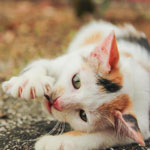Declaw Awareness Day Date in the current year: March 29, 2025
 Declaw Awareness Day, also know as National Don’t Declaw Your Cat Awareness Day, is observed annually on March 29. It aims to raise awareness of the cruel practice of feline declawing, which is prohibited or significantly restricted in some countries and should be banned worldwide.
Declaw Awareness Day, also know as National Don’t Declaw Your Cat Awareness Day, is observed annually on March 29. It aims to raise awareness of the cruel practice of feline declawing, which is prohibited or significantly restricted in some countries and should be banned worldwide.Cats have sharp claws that they use to hunt, climb trees, and protect themselves. When they experience stress or anxiety, they may scratch furniture or lash out at humans or other pets, scratching them. Most cat owners would trim their cat’s claws every few weeks to protect their possessions and family, but some go as far as to declaw their cat.
Declawing, also known as onychectomy, is a surgical procedure that aims to remove the cat’s claws. The name “declawing” is misleading because it’s not just the claws that are removed. Most people do not realize that a surgeon cannot remove the claw without removing part of the animal’s toe. So declawing is in fact amputation of a cat’s toes at the last joint, and “de-knuckling” is a more fitting name for the procedure.
Declawing is not a minor surgery; it is a major procedure that involves severing the ligaments, tendons and nerves in each toe of a cat’s paws. It may have multiple complications. Some cats begin to suffer complications shortly after the procedure, but a number of adverse health effects associated with declawing may not manifest themselves until months or even years later. They include adverse behaviors (aggression, biting, overgrooming, inappropriate toileting), chronic back pain, arthritis, dermatitis, lameness, and more.
But why do some vets perform this procedure that has a multitude of adverse effects and no health benefits? Alas, money rules the world. Some vets would rather harm an animal than lose a client. Of course, not all vets are like that; many of them refuse to perform the procedure and would strongly discourage cat owners from having their cats declawed.
Declawing is banned or significantly restricted in more than 20 countries, including many European countries (for example, Austria, Estonia, Finland, Germany, the Netherlands, Sweden, Switzerland, and the United Kingdom), Australia (except for New South Wales), Brazil, Japan, Israel, and New Zealand. It is also outlawed in seven of ten Canadian provinces and parts of the United States. In some jurisdictions, declawing is classified as an act of animal cruelty.
Declaw Awareness Day is promoted by The Paw Project and other organizations that fight to ban this cruel and potentially crippling procedure. The main goals of this awareness day are to educate cat owners about the adverse effects of declawing and to promote healthy alternatives to the procedure.
What are the main alternatives to declawing? They include providing your cat with a scratching post, making sure that your family members treat your cat right, and regularly trimming your cat’s claws. You can also try nail caps; although they are not a universal solution, they do work for some cats and their owners. Please keep in mind that tendonectomy, which is promoted as a less painful alternative to declawing, is just as harmful.
- Category
- Ecological Observances
- Tags
- Declaw Awareness Day, National Don’t Declaw Your Cat Awareness Day, awareness day, declawing, The Paw Project